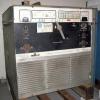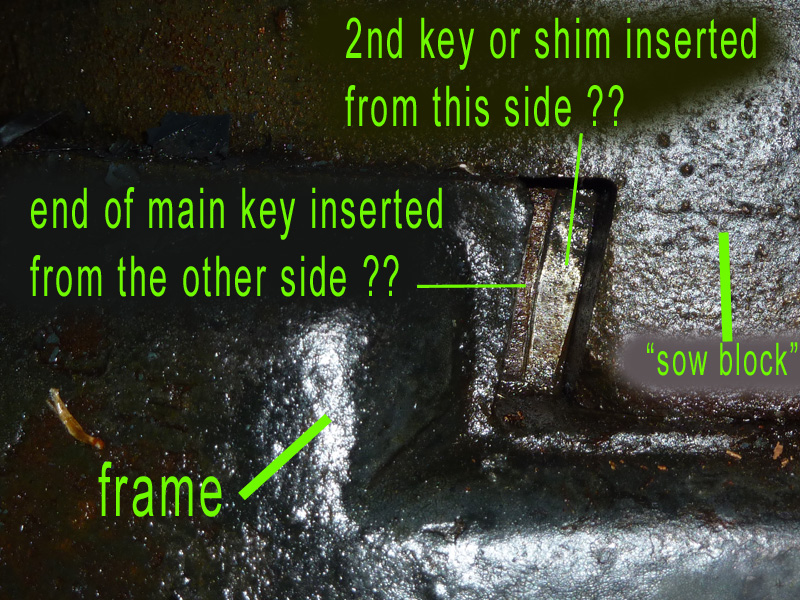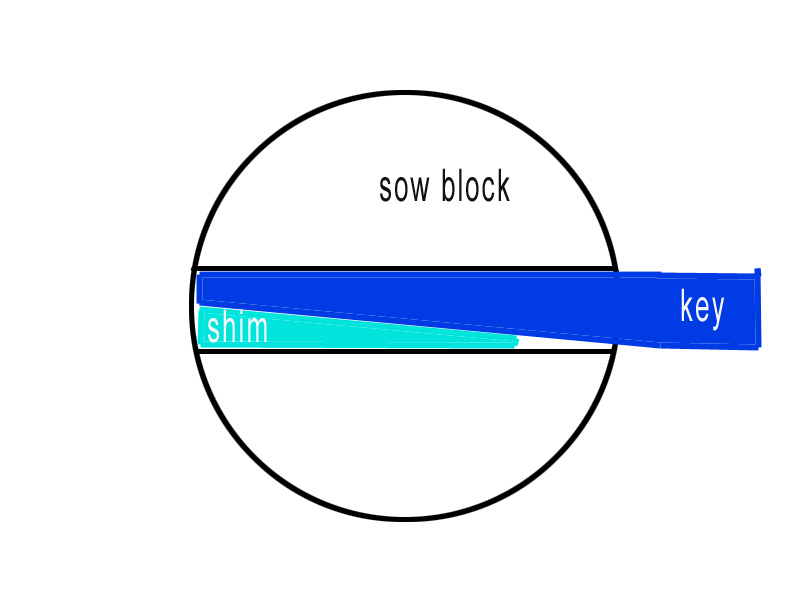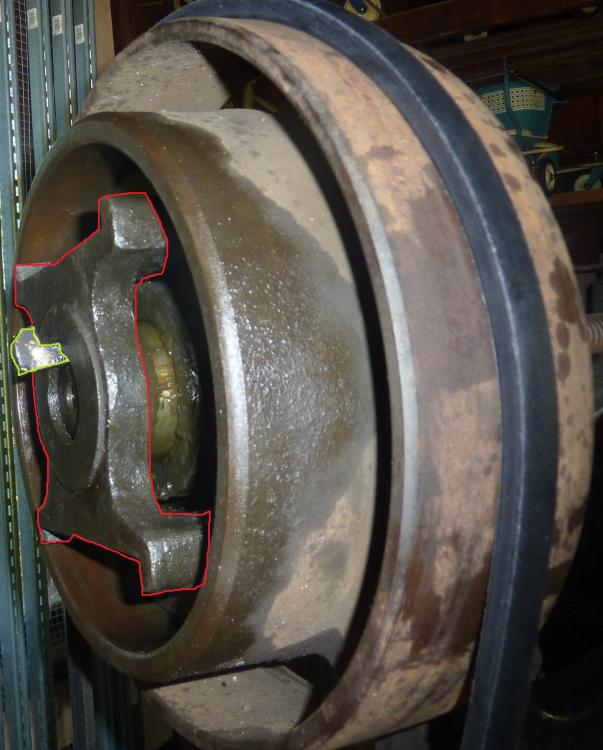
potatoeman
Members-
Posts
29 -
Joined
-
Last visited
Contact Methods
-
Website URL
http://www.coroflot.com/tater/profile
Profile Information
-
Gender
Male
-
Location
St. Paul, MN
-
Interests
blades, pattern welding
Recent Profile Visitors
-
25 lb. little giant dies mis-alligned ?
potatoeman replied to potatoeman's topic in Power Hammers, Treadle Hammers, Olivers
ugh ! ok, thanks Frosty. one thing: from the blind side, I'm not sure which of those bars actually sticks out the other side...... If I hammer on the wrong one, won't I make it even tighter ? -
25 lb. little giant dies mis-alligned ?
potatoeman replied to potatoeman's topic in Power Hammers, Treadle Hammers, Olivers
again, thanks to everyone for their helpful responses. The copper shims are an interesting idea... I decided to try to shim out the "sow block", there seems to be the most wiggle room there. but I can't get the key out. The previous owner put in a second key of shim from the other side of the sow block as the main key,and I didn't realize this until i had pounded on the blind end for 10 minutes, looks like I mushroomed the ends a little bit. My question now is: is there a trick to pulling out the sowblock key the way in went in (without hammering on the thin end)? I tried welding a bar onto the protruding key and hammerin g on ther bar, but the welds keep breaking. I thought maybe I could thread the end of the key with a threading die, put a big nut on the end, and crank it off ? here's a top down view of the important parts for clarification. Not to scale. How do I get the blue key out ? somebody must have done this kind of thing before...? -
25 lb. little giant dies mis-alligned ?
potatoeman replied to potatoeman's topic in Power Hammers, Treadle Hammers, Olivers
It has a sow block. You are correct, it looks like shimming the sow block 3'32" would do the trick as well. But I can't remove it. I tried hammering out the key, and after a while I realized, there are two keys, one hammered in from each side, with one key buried in the keyway 3 inches deep. So it's impossible to tell which key to pound out. I thought I could arc weld a bar onto the key that is sticking out, then I could hammer 'backwards' on the protruding key to pull it out.....if you can understand that. -
25 lb. little giant dies mis-alligned ?
potatoeman replied to potatoeman's topic in Power Hammers, Treadle Hammers, Olivers
Frosty and Forgemaster, thanks you so much for taking the time to reply. I checked the keys and they are in the right positions. The offset is 3/32" approximately. I talked to Roger Rice at Little Giant, and he makes a 1/8" thinner key for that die, which would it put within 1/32", which hopefully can be shimmed to make it perfect. I'll post a pic when I get it in place. -
25 lb Little Giant won't "idle"
potatoeman replied to potatoeman's topic in Power Hammers, Treadle Hammers, Olivers
Seems to work now; it runs on, once I step on the treadle, but I might just need to go back and do another pass of the cleaning. It probably wouldn't hurt to add a brake as well. Thanks to Hwooldridge, Jeremy K and swedefiddle for taking the time to help me out !- 15 replies
-
- little giant
- clutch
-
(and 1 more)
Tagged with:
-
25 lb Little Giant won't "idle"
potatoeman replied to potatoeman's topic in Power Hammers, Treadle Hammers, Olivers
I think I got it. I sprayed the crap out of it, literally, by dousing all the wearing surfaces where wheel meets shaft with half a can each of degreaser, WD-40 and PB blaster (rusty nut loosener) I am now unable to move the flywheel by spinning the big pulley wheel, and it spins quite freely now. I could feel it getting easier with each ounce of petroleum distilate I sprayed on. I'm going to re-oil and re-grease everything and give it a go....- 15 replies
-
- little giant
- clutch
-
(and 1 more)
Tagged with:
-
25 lb Little Giant won't "idle"
potatoeman replied to potatoeman's topic in Power Hammers, Treadle Hammers, Olivers
This is what it looks like. Can I take off the friction spyder? (red outline) by removing the key (green outline) is it that simple ? Will I possible break things ? There might be a lot of grease and dirt stuck behind there ?- 15 replies
-
- little giant
- clutch
-
(and 1 more)
Tagged with:
-
25 lb Little Giant won't "idle"
potatoeman replied to potatoeman's topic in Power Hammers, Treadle Hammers, Olivers
@ Jeremy: I greased that zerk until until it was coming out the nose and ears, before I even plugged it in.....- 15 replies
-
- little giant
- clutch
-
(and 1 more)
Tagged with:
-
25 lb Little Giant won't "idle"
potatoeman replied to potatoeman's topic in Power Hammers, Treadle Hammers, Olivers
Interesting....I removed both wooden clutch blocks, and nothing seems to have changed. It hammers fast with the motor on, and the "spider"? clutch wheel thing still turns a little when I move the belts by hand. It must be sticking somewhere else....- 15 replies
-
- little giant
- clutch
-
(and 1 more)
Tagged with:
-
25 lb Little Giant won't "idle"
potatoeman replied to potatoeman's topic in Power Hammers, Treadle Hammers, Olivers
ok-good idea about removing the clutch blocks, that would be an easy test. Before I oiled everything, I could pull on the belt by hand and the clutch would stick and the hammer would go up and down. Now if I rotate by hand, the clutch sticks and rotates maybe 10 degrees, then slips and falls back. @ Jeremy: At first, if I would step on the treadle, sometimes the clutch blocks would stick in the "on" position. I put a bunch of bar-and-chain oil on the clutch-collar area, now the spring returns everything pretty quickly when I take my foot off the treadle. Pulling up on the treadle doesn't do anything, the spring pulls it all the way up.- 15 replies
-
- little giant
- clutch
-
(and 1 more)
Tagged with:
-
25 lb Little Giant won't "idle"
potatoeman posted a topic in Power Hammers, Treadle Hammers, Olivers
I bought a 25 LG (new style) and I'm trying to get it working. It's in fantastic condition and looks like it's hardly been used. It was probably last used in about 1980 ? I put a new 1.5 hp motor with a double pulley and v-belt drive on it, and when I switch it on, it hammers at full speed. I've oiled the blocks and all the oil and grease points detailed on the Little Giant website, and I'm not sure what to try next. Is there an adjustment screw for the clutch ? There is no visible wear on the blocks and there is just enough room to slip a thin business card between the blocks and the wheel (that they press against). I was thinking of reversing the direction the motor turns, maybe the hammer ran the other direction in it's previous life ?- 15 replies
-
- little giant
- clutch
-
(and 1 more)
Tagged with:
-
The idea of adding sand is good. I've been toying with a forge design where the floor and walls of the forge are shaped to let the melted flux that drips off to drain out the front of the forge, rather than just puddling inside.
-
The flux has two jobs; eat oxide off the steel and prevent new oxide from forming by shielding the piece from oxygen. If you start with a clean workpiece, maybe you only need an oxygen barrier to protect the steel while it heats up ? English smiths, apparently, don't use any flux at all ?
-
It seems like everyone goes to a lot of trouble to line their welding forges with stuff that will resist the corrosive action of caustic borax flux. Is there a commercially available flux that won't eat through ceramic fiber insulation blankets ? Maybe a guy could pay a little more for commercial flux, but his forge would last longer and be safer ? This from Wikipedia: Early examples of flux used different combinations and various amounts of iron fillings, borax, sal ammoniac, balsam of copaiba, cyanide of potash, and soda phosphate. The 1920 edition of Scientific American book of facts and formulae indicates a frequently offered trade secret as using copperas, saltpeter, common salt, black oxide of manganese, prussiate of potash, and "nice welding sand" (silicate). Would one of these formulas work just as well, and not eat through the forge lining ? Is all that stuff safe to breathe ? Is borax safe to breathe ?







